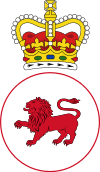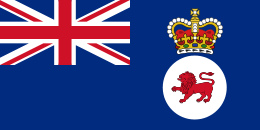William Allardyce
| Sir William Lamond Allardyce GCMG | |
|---|---|
 | |
| Acting High Commissioner for the Western Pacific | |
|
In office 1901 – 10 September 1902 | |
| Monarch | Edward VII |
| Preceded by | George Thomas Michael O'Brien |
| Succeeded by | Henry Moore Jackson |
| Acting Governor of Fiji | |
|
In office 1901 – 10 September 1902 | |
| Monarch | Edward VII |
| Preceded by | George Thomas Michael O'Brien |
| Succeeded by | Henry Moore Jackson |
| 13th Governor of the Falkland Islands | |
|
In office March 1904 – February 1914 | |
| Monarch |
Edward VII George V |
| Preceded by | William Grey-Wilson |
| Succeeded by | William Douglas Young |
| 48th Governor of the Bahamas | |
|
In office 15 June 1914 – 8 December 1920 | |
| Monarch | George V |
| Preceded by | Sir George Basil Haddon-Smith |
| Succeeded by | Sir Harry Edward Spiller Cordeaux |
| 13th Governor of Tasmania | |
|
In office 16 April 1920 – 27 January 1922 | |
| Monarch | George V |
| Preceded by | Sir Francis Newdegate |
| Succeeded by | Sir James O'Grady |
| 5th Governor of Newfoundland | |
|
In office 1 September 1922 – 1 October 1928 | |
| Monarch | George V |
| Prime Minister |
Richard Squires William Warren Albert Hickman Walter Stanley Monroe Frederick C. Alderdice |
| Preceded by | Charles Alexander Harris |
| Succeeded by | John Middleton |
| Personal details | |
| Born |
14 November 1861 Bombay, Maharashtra, India |
| Died |
10 June 1930 (aged 68) Wokingham, Berkshire, England |
| Spouse(s) |
Constance Angel Greene, m.1895, d.1919) Elsie Elizabeth Goodfellow, (nee Stewart, m.1920) |
Sir William Lamond Allardyce GCMG (14 November 1861 – 10 June 1930) was a career British civil servant in the Colonial Office who served as governor of Fiji (1901–1902), the Falkland Islands (1904–1914), Bahamas (1914–1920), Tasmania (1920–1922), and Newfoundland (1922–1928).
Allardyce was born near Bombay, India, the son of Georgina Dickson Abbott and Colonel James Allardyce. Educated in Aberdeen, Scotland and at Oxford Military College, at the age of 18 he joined the British Civil Service in the Colonial Office.
His first posting was Fiji where only two years after arriving there he was named acting Resident Commissioner for the island of Rotuma. The following year as magistrate and seven years later he was appointed to the Native Regulation Board and made the commissioner of the Supreme Court. In 1894 he was made Commissioner for Native Lands and given a seat in the Legislative Council. In 1895 he was appointed Native Commissioner, the chief liaison between the Fijian natives and the British.
In 1904 Allardyce was appointed as Governor of the Falkland Islands. After 10 years at the Falklands he was then transferred to the Bahamas to become its governor. A post he held for six years. Allardyce then became governor of Tasmania, but retired after only two years—taking the last three months as leave—as a result of his failure to obtain an increase in his salary of £2750. In fact a statement made to the Parliament of Tasmania on his salary and allowances was followed by a vote by the Legislative Assembly to abolish his office, although the same motion was defeated in the Legislative Council. Nevertheless, when he left office he was widely praised for his performance of the office.[1]
Allardyce was subsequently ordered to Newfoundland where he was to succeed Sir Charles Alexander Harris as Governor of Newfoundland, where he was invited to become patron of the Great War Veterans Association. He was the official Crown representative of the unveiling of the National War Memorial by Field Marshal the Earl Haig on 1 July 1924. He officiated at the opening of the other national war memorial, Memorial University College, on 15 September 1925. Allardyce as governor was a key promoter in the decision awarding jurisdiction over most of the Labrador Peninsula to Newfoundland by the British Privy Council.
In 1916 Allardyce was made Knight Commander of the Order of Saint Michael and St. George by King George V. Some years later he became Knight Grand Cross in 1927.
Allardyce married twice, first to Constance Greene of Melbourne, Australia in 1895. She died in 1918; he then in 1920 married Elsie Elizabeth Stewart,[2] widow of A.C. Goodfellow. In 1923, Lady Allardyce helped start the Girl Guide movement in Newfoundland, and then in 1924 she established the Newfoundland Outport Nursing and Industrial Association (NONIA).
Allardyce was noted as one of the most competent administrators ever appointed by the Colonial Office to serve as the official representative of the British Crown in Newfoundland and Labrador.
See also
- List of people of Newfoundland and Labrador
- William Kerr Stewart Lamond of Jersey
- Nicholas Charles Stewart Lamonod of Surrey
References
- ↑ McLeod, E. A. (1979). "Allardyce, Sir William Lamond (1861–1930)". Australian Dictionary of Biography. Canberra: Australian National University. Retrieved 15 May 2008.
- ↑ "Lady Elsie Elizabeth Allardyce (née Stewart), Second wife of Sir William Lamond Allardyce; previous wife of Adam Goodfellow; daughter of James Stewart". National Portrait Gallery, London.
External links
| Government offices | ||
|---|---|---|
| Preceded by Sir George O'Brien |
High Commissioner for the Western Pacific, acting 1901–1902 |
Succeeded by Sir Henry Jackson |
| Governor of Fiji, acting 1901–1902 | ||
| Preceded by Sir William Grey-Wilson, KCMG |
Governor of the Falkland Islands 1904–1914 |
Succeeded by Sir William Young, KBE, CMG |
| Preceded by Sir George Haddon-Smith |
Governor of the Bahamas 1914–1920 |
Succeeded by Sir Harry Cordeaux |
| Preceded by Sir Francis Newdegate |
Governor of Tasmania 1920–1922 |
Succeeded by Captain James O'Grady |
| Preceded by Sir Charles Alexander |
Dominion Governor of Newfoundland 1922–1928 |
Succeeded by Sir John Middleton |

